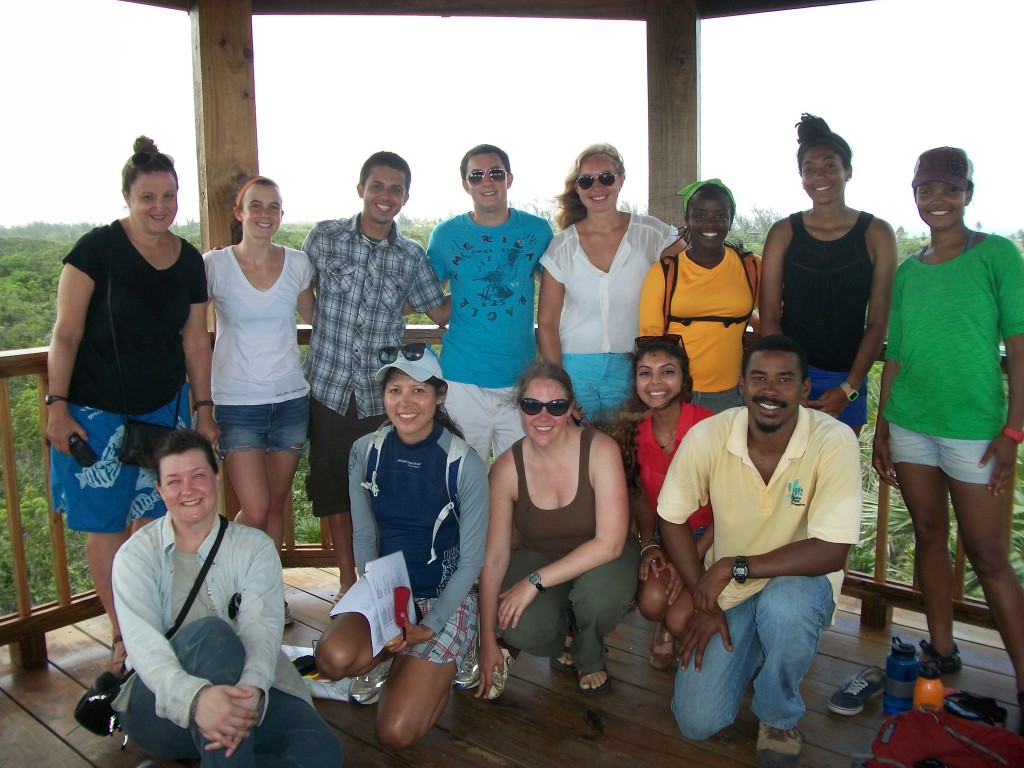The Research Experience for Undergrads- Bahamas group just completed a two week stay in Eleuthera. While down here, they participated in some archaeological research, and blogged about it! Check out their blog at: http://reubahamas.wordpress.com/
Wemyss Bight Primary School Meets live animals at The Island School and CEI May 28, 2013 & June 6, 2013
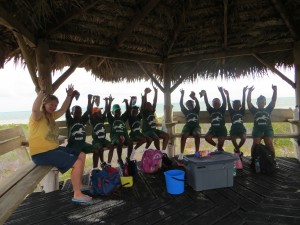 The Grade twos and threes from Wemyss Bight Primary School have each come to visit The Island School campus and learn all about how animals get their food, water and protection in order to survive. After meeting and greeting the Educational Program staff, the students went to feed the pigs at the Island School Farm. On site we have six incredibly large pigs that consume much of the food waste from our dining hall. The grade three students helped Fran shovel the leftover food into the pig pen and students and pigs equally squealed with delight. Next, the students met (and pet!) our Muskovy ducks that provide eggs for our kitchen and saw a mother duck incubating her egg.
The Grade twos and threes from Wemyss Bight Primary School have each come to visit The Island School campus and learn all about how animals get their food, water and protection in order to survive. After meeting and greeting the Educational Program staff, the students went to feed the pigs at the Island School Farm. On site we have six incredibly large pigs that consume much of the food waste from our dining hall. The grade three students helped Fran shovel the leftover food into the pig pen and students and pigs equally squealed with delight. Next, the students met (and pet!) our Muskovy ducks that provide eggs for our kitchen and saw a mother duck incubating her egg.
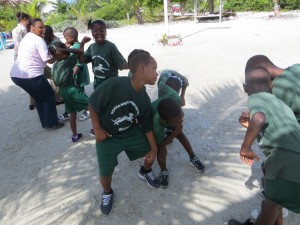
After a snack break, the students explored how a variety of marine invertebrates survive in the ocean. They touched sea urchins, juvenile conch and a sea star. Throughout their visit, the students discovered different ways The Island School and CEI strive to tread lighter on our planet and balanced all this information out with a few silly games and tons of songs. We dropped them off back at WBPS with giant smiles, high fives and hugs just in time for lunch. The Educational Program staff is looking forward to working with the Grade six class from Governors Harbour next week!
Shark Expedition Update #4
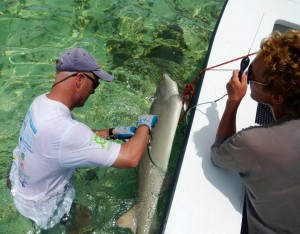
Morgan’s Bluff: The expedition continued in Morgan’s Bluff on the north side of Andros from May 30th through June 2nd. While sawfish weren’t found in this area, seven more lemon sharks were sampled, bringing the total to 26 genetic samples. NOAA scientist Dr. John Carlson fitted a subadult female lemon shark with a satellite archival tag, which will yield information on movement of this demographic as well as the efficacy of the tag in shallow water.
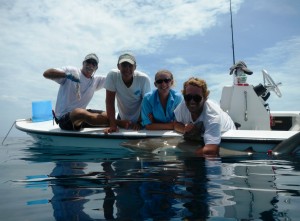
Fresh Creek: The team returned to Nassau before heading back out to Fresh Creek on Andros’ east side. Fresh Creek lived up to its name’s reputation by being quite fresh, and at a glance, devoid of lemon or nurse sharks. Lemon sharks were spotted outside the mouth of the creek on flats south of the AUTEC U.S. Navy base. Fishing for lemons turned out to be a fruitless effort, so the team headed out to deeper water to try and tackle another project goal: satellite tagging great hammerheads. In deeper waters the team caught several Caribbean reef sharks and silky sharks, but no hammerheads yet.
Update from SFU visiting lionfish researchers
Through perseverance and teamwork, the SFU team, stationed at The Cape Eleuthera Institute, has made great progress in gathering biological samples to assess the effects of the lionfish predation and other stressors on food webs of local reefs. So far they have sampled 7 out of 16 sites, catching over 300 different fish of different species. The structure and complexity of some sites greatly complicates the sampling effort, so as with any other fishing activities, “some days are better than others”.
It is important to note that their sampling effort is completely non-destructive (yay!)… But what does this mean? Well, they bring the fish up to the boat, fin-clip them, let them recover in floating cages hanging from the boat for 20 min, and then release them back to their home. Continue reading
Conch Fest 2013
This past weekend, CEI participated in Conch Fest, the Homecoming celebration for the settlement of Deep Creek, where several CEI staff call home. The focus of this year’s booth was to promote the National Conchservation Campaign, as well as to serve lionfish samples as an alternative to conch.
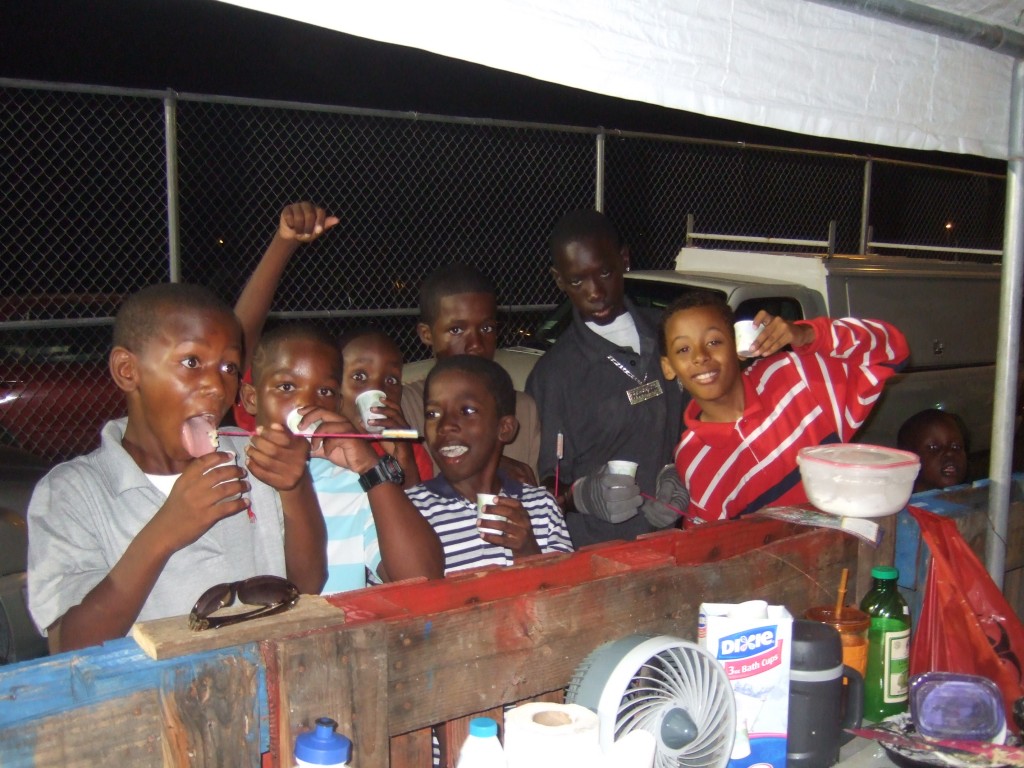
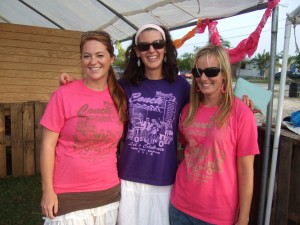
On Friday night, we served up fried lionfish, fresh out of the fryer. We gave away over 100 samples! Dozens of people came up saying “no you can’t eat that, it’ll kill you!” The truth is, lionfish do have venomous spines, but the meat is healthy and delicious, and once the fish is filleted it can be enjoyed in a variety of ways. Educating the community on the truth behind handling and eating lionfish was a priority for the researchers who came out to volunteer at the fest. Continue reading
Spring 2013 CEI/IS Research Symposium was a success!
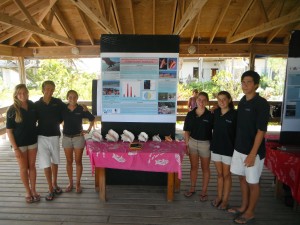
This past Saturday, CEI and IS hosted their Spring 2013 Research Symposium. The event consisted of research presentations and poster sessions, where Island School students got the chance to present their semester’s worth of work to staff, community members, visiting scientists, and representatives from some Bahamian NGO’s, including Save our Bays. After giving brief presentations that discussed everything from the purpose of the research to data analysis and interpretation, IS students had the chance to attend their first poster session as
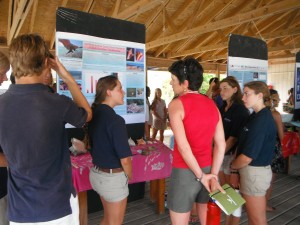
young scientists. After working on the posters all semester, students were proud to showcase their effort, and share what they learned with those that were interested. The Symposium culminated with keynote speakers Dr. John Tiedemann (Monmouth University) and Dr. Mark Hixon (University of Hawaii), addressing the students and motivating them to continue their critical thinking as they move on to college.
Queen Conch Research Update
This past semester, researchers, students, and volunteers have been busy surveying South Eleuthera’s shoreline, looking for queen conch juveniles. Under the direction of CEI researcher Claire Thomas, survey methods were implemented to identify essential queen conch nursery habitat.
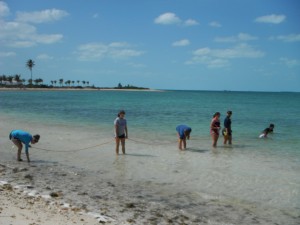
Queen conch populations are declining in Eleuthera. Past research has shown that protection of adult conch alone is not adequate to protect the whole population, as juveniles and adults utilize different habitat types. Adults are generally found in deeper water in sandy areas, whereas juveniles will be in shallow water, most often in seagrass beds, where they graze on detritus and algae. To ensure that protection is sufficient, juvenile populations also have to be protected.
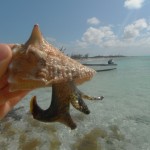
The government of the Bahamas, along with the Bahamas National Trust, are interested in creating a Marine Protected Area, or No-Take Zone, off the waters of South Eleuthera. The CEI Queen Conch Research Program aims to identify hot spots of juvenile queen conch, through their shoreline surveys, to inform officials of an important place to protect. In the summer, during queen conch mating season, SCUBA transects will be done to identify aggregations of adult queen conch. This information is also important, as breeding grounds are another essential habitat in the queen conch life cycle.
CEI Symposium, a chance to highlight work done this spring
Last week, our second CEI Symposium kicked off with the first night of presentations by Liz Underwood on lionfish reproduction sites, Skylar Miller discussing larval lionfish recruitment, Maddy Young on flats ecology, and Melissa Dick on mangrove cultivator pots. The second night yielded interesting presentations by Peter Wilson on the oceanic whitetip shark expedition, Lauren Horton on stingray physiology, Will Urmston presenting on the best medium to plant microgreens in, and Kristal Ambrose presenting on her beach plastic research.
CEI hosts a large variety of research projects and this symposium is a great way to showcase the hard work done by the interns for the past five months. Nice job everyone!
Shark Expedition Update #3

On May 25th, researchers from Stony Brook University’s School of Marine and Atmospheric Science and NOAA’s Southeast Fisheries Science Center Panama City Lab, along with CEI Shark intern Ian Bouyoucos, departed from Nassau via seaplane to Andros. They spent the next three days at the Flamingo Cay Rod and Gun Club exploring the west side of Andros. The focus of this leg of the expedition is to 1) take genetic samples from lemon and bonnethead sharks, and 2) to find the critically endangered smalltooth sawfish (a cartilaginous fish, closely related to stingrays).
Smalltooth sawfish populations have declined by over 90% in no small part due to their susceptibility to accidental capture in gill nets. Andros is one of the few places outside of the U.S. where smalltooth sawfish are found. NOAA researchers plan on outfitting these sawfish with archival satellite tags to learn more about their movement patterns.
Lionfish/Lobster experiments
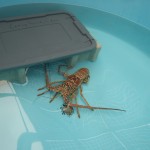
The lionfish program trials for their lobster lionfish displacement experiment are well underway. After many hours of work, all three “lobster cams” are now up and running which was only possible with the help of several staff from different departments around CEI.
Fishermen have given accounts that lionfish are invading their lobster traps, and it is affecting their income. To test if lionfish are capable of displacing lobster from their habitat, infrared cameras were set up to film the interactions of behaviors that occur between lionfish and lobster through both day and night. We already have many hours of footage and have seen some exciting behaviors.
Click on the link below to checkout some sample footage (This link downloads a .avi video file so please check your recent downloads after clicking):
